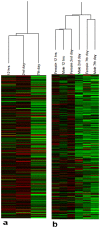Gender differences in a Drosophila transcriptomic model of chronic pentylenetetrazole induced behavioral deficit
- PMID: 19956579
- PMCID: PMC2779862
- DOI: 10.1371/journal.pone.0008136
Gender differences in a Drosophila transcriptomic model of chronic pentylenetetrazole induced behavioral deficit
Abstract
A male Drosophila model of locomotor deficit induced by chronic pentylenetetrazole (PTZ), a proconvulsant used to model epileptogenesis in rodents, has recently been described. Antiepileptic drugs (AEDs) ameliorate development of this behavioral abnormality. Time-series of microarray profiling of heads of male flies treated with PTZ has shown epileptogenesis-like transcriptomic perturbation in the fly model. Gender differences are known to exist in neurological and psychiatric conditions including epileptogenesis. We describe here the effects of chronic PTZ in Drosophila females, and compare the results with the male model. As in males, chronic PTZ was found to cause a decreased climbing speed in females. In males, overrepresentation of Wnt, MAPK, TGF-beta, JAK-STAT, Cell communication, and Dorso-Ventral axis formation pathways in downregulated genes was previously described. Of these, female genes showed enrichment only for Dorso-Ventral axis formation. Surprisingly, the ribosomal pathway was uniquely overrepresented in genes downregulated in females. Gender differences thus exist in the Drosophila model. Gender neutral, the developmental pathway Dorso-Ventral axis formation may be considered as the candidate causal pathway in chronic pentylenetetrazole induced behavioral deficit. Prior evidence of developmental mechanisms in epileptogenesis may support potential usefulness of the fly model. Given this, gender specific pathways identified here may provide a lead for further understanding brain dimorphism in neuropsychiatric disorders.
Conflict of interest statement
Figures



Similar articles
-
A Drosophila systems model of pentylenetetrazole induced locomotor plasticity responsive to antiepileptic drugs.BMC Syst Biol. 2009 Jan 21;3:11. doi: 10.1186/1752-0509-3-11. BMC Syst Biol. 2009. PMID: 19154620 Free PMC article.
-
Transcriptomic analysis in a Drosophila model identifies previously implicated and novel pathways in the therapeutic mechanism in neuropsychiatric disorders.Front Neurosci. 2011 Mar 31;5:161. doi: 10.3389/fnins.2011.00161. eCollection 2011. Front Neurosci. 2011. PMID: 21503142 Free PMC article.
-
Detection of transgenerational spermatogenic inheritance of adult male acquired CNS gene expression characteristics using a Drosophila systems model.PLoS One. 2009 Jun 2;4(6):e5763. doi: 10.1371/journal.pone.0005763. PLoS One. 2009. PMID: 19503609 Free PMC article.
-
Pb2+: an endocrine disruptor in Drosophila?Physiol Behav. 2010 Feb 9;99(2):254-9. doi: 10.1016/j.physbeh.2009.09.014. Epub 2009 Sep 30. Physiol Behav. 2010. PMID: 19800356 Review.
-
Dopamine dynamics and signaling in Drosophila: an overview of genes, drugs and behavioral paradigms.Exp Anim. 2014;63(2):107-19. doi: 10.1538/expanim.63.107. Exp Anim. 2014. PMID: 24770636 Free PMC article. Review.
Cited by
-
Efficient strategies based on behavioral and electrophysiological methods for epilepsy-related gene screening in the Drosophila model.Front Mol Neurosci. 2023 Apr 20;16:1121877. doi: 10.3389/fnmol.2023.1121877. eCollection 2023. Front Mol Neurosci. 2023. PMID: 37152436 Free PMC article.
-
Sex differences and rapid estrogen signaling: A look at songbird audition.Front Neuroendocrinol. 2015 Jul;38:37-49. doi: 10.1016/j.yfrne.2015.01.001. Epub 2015 Jan 28. Front Neuroendocrinol. 2015. PMID: 25637753 Free PMC article. Review.
-
Acute neuroestrogen blockade attenuates song-induced immediate early gene expression in auditory regions of male and female zebra finches.J Comp Physiol A Neuroethol Sens Neural Behav Physiol. 2020 Jan;206(1):15-31. doi: 10.1007/s00359-019-01382-w. Epub 2019 Nov 28. J Comp Physiol A Neuroethol Sens Neural Behav Physiol. 2020. PMID: 31781892 Free PMC article.
-
Serotonin distinctly controls behavioral states in restrained and freely moving Drosophila.iScience. 2022 Dec 28;26(1):105886. doi: 10.1016/j.isci.2022.105886. eCollection 2023 Jan 20. iScience. 2022. PMID: 36654863 Free PMC article.
-
Serotonergic control of feeding microstructure in Drosophila.Front Behav Neurosci. 2023 Jan 17;16:1105579. doi: 10.3389/fnbeh.2022.1105579. eCollection 2022. Front Behav Neurosci. 2023. PMID: 36733453 Free PMC article.
References
-
- Christensen J, Kjeldsen MJ, Andersen H, Friis ML, Sidenius P. Gender differences in epilepsy. Epilepsia. 2005;46:956–960. - PubMed
-
- Nguon K, Ladd B, Baxter MG, Sajdel-Sulkowska EM. Sexual dimorphism in cerebellar structure, function, and response to environmental perturbations. Prog Brain Res. 2005;148:341–351. - PubMed
-
- Nickel J, Jokeit H, Wunderlich G, Ebner A, Witte OW, et al. Gender-specific differences of hypometabolism in mTLE: implication for cognitive impairments. Epilepsia. 2003;44:1551–1561. - PubMed
-
- Lemmens EM, Lubbers T, Schijns OE, Beuls EA, Hoogland G. Gender differences in febrile seizure-induced proliferation and survival in the rat dentate gyrus. Epilepsia. 2005;46:1603–1612. - PubMed
Publication types
MeSH terms
Substances
LinkOut - more resources
Full Text Sources
Molecular Biology Databases
Research Materials

